Menus
- GT almost Sport – 4,000 km test
- Discovery
- In the saddle
- Contact
- First turns of the wheel
- City
- Highway
- Departmental
- Night road
- Comfort
- Duo
- Brakes
- Tires
- Convenient
- Consumption
- Conclusion
GT almost Sport – 4,000 km test
Appeared in 2001, winning ABS in 2002, the FJR is the quintessential Yamaha GT, including the gimbal. Just below 15,000 euros when it was launched, it is the best value for money in the category against the Germans and the Pan-European.
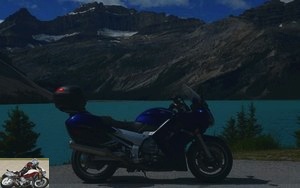
Discovery
The FJR is instantly recognizable by its large GT size, its dual frontal optics, its encompassing fairing, its adjustable electric screen and a long saddle. Originally fitted with side cases, it is readily adorned with a top case. Two long exhausts frame a wide rear tire. A central stand completes the lateral.
Note on the side the rear suspension hardness adjustment lever and the absence of chain.
The dashboard incorporates counter and analog tachometer on the left and in the center, completed by a digital display on the right: fuel gauge, partial double trip, totalizer, oil temperature, clock.
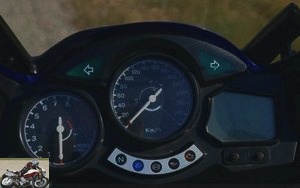
A keyless storage compartment is placed on the left. The warnings are placed just below.
The overall finish is excellent.
In the saddle
The feet touch the ground, but nothing more for the 1.70m pilot. The wide saddle is responsible for this despite a reasonable height of only 805mm. The wide handlebars immediately fall under the hands. The overall handlebar, saddle and footrest position is rather straight. The footrests are at the correct height.
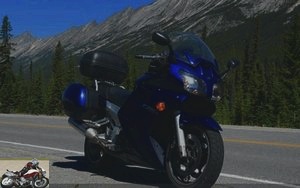
Contact
The counter resets. Inline-four V-cylinder quietly purrs with a deep sound.
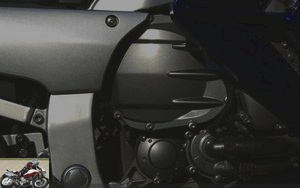
First turns of the wheel
First, the gearbox hangs noisily (71,000 km from the test model requires) but the bike starts immediately and quickly finds its balance. Do not hesitate to pull the first gear a little to avoid possible jerks (especially since it accepts to go up to 80 km / h). The second goes quickly, then the third. Everything can run on idle and is very smooth under 3,000 rpm. We feel a net better and a real thrust from 4,000 rpm.
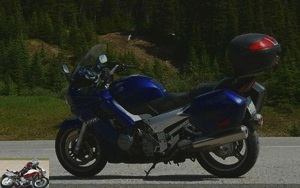
City
The FJR is easy, especially considering its size. It’s the bulkiness and side cases that may require a little extra attention, but it works pretty well between the lines. Slow-speed maneuvers require a minimum of attention, however, so as not to forget its 300 kilos (251 kilos dry but with a 25-liter tank, plus the kilos in the suitcases and the pilot and passenger ….).
On the other hand, it heats up quickly; even more heat in summer when it is already barely bearable in winter, especially in the thighs and especially on the left. A tank mat significantly reduces this problem according to regular owners.
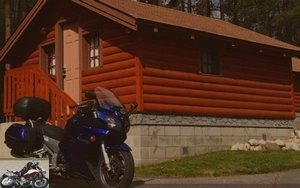
Highway
The FJR quickly entered the motorway. At 5,000 rpm, it is already at 135 km / h and very far from the 9,000 rpm of the red zone. It then picks up 25 km / h for every additional 1,000 rpm, up to a theoretical maximum speed of 235 km / h.
After 130 km / h, in 5th gear, acceleration is regular, but slow. The slightest overshoot requires falling two gears to be able to climb the towers and pass safely..
The bubble protects well up to 180 km / h. We feel a slight shimmy at this speed, improved when removing the top case.
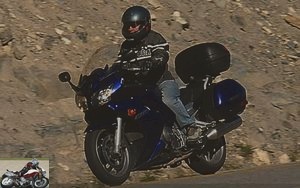
Departmental
The FJR rolls quietly on departmental and does not disdain to go down one or two reports to accelerate the pace. The driving then becomes a little more muscular as the pace picks up. The bike is still healthy but requires a minimum of control and anticipation, not forgiving rough trajectories by a last minute catch.
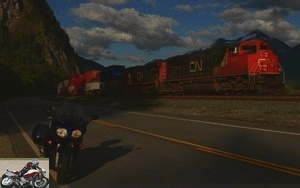
Night road
It lights correctly, nothing more. The full headlight brings especially a surplus of power in width but hardly in distance. We therefore reduce the speed compared to the daytime road..
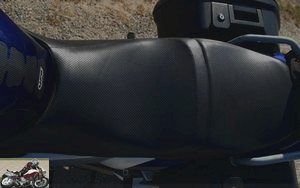
Comfort
The saddle is soft for both rider and passenger. The suspensions effectively erase road defects while offering excellent comfort, even in a "hard" position..
Duo
The FJR is perfectly suited to the duo, allowing long non-stop outings. It is comfortable and the passenger footrests are well placed in height. Their only flaw is the proximity of the exhausts which heat the whole enormously..
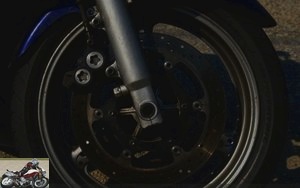
Brakes
The rear brake is an honorable retarder. The front brake offers good progressiveness and efficiency. ABS turns out to be pleasant.
Tires
Originally fitted with Metzeler 4, the BT 20s are tires that suit him better afterwards (test fitting).
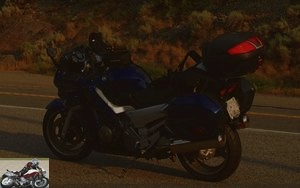
Convenient
Suitcases can be opened and closed easily, with the same key as the ignition key. Do not hesitate to load both the inner side and the outer part of each suitcase to take full advantage of it. Straps facilitate the operation. They can be easily removed for transport without removing the bags.
The electrically adjustable screen on the handlebars is very practical. In hot weather, we prefer to leave it in the low position, the wind then blowing on the upper part of the bust with a pleasant "air conditioning" effect. In the high position, the wind is completely deflected, but on the other hand generates infra-sounds at the level of the helmet * which can be unpleasant on a long journey (* phenomenon which may vary depending on the helmet).
However, it suffices to lean a little, reducing the pilot-bubble distance, to suppress this noise. But the position is then not at all so natural.
The bubble retracts automatically when the ignition is switched off.
Under the saddle there is room for rain pants.
Consumption
On the motorway and at legal stabilized speed, consumption stabilizes at 5.5 liters per hundred. It can climb to 7 or even 8 liters if you exceed the legal speeds or on small mountain roads..
As the gauge has 8 sticks, each stick fades on average after 50 km, for the first 6, the next two after 30 km before reaching reserve. On reserve, the totalizer begins to increment the counter to calculate the number of kilometers made since the passage in reserve.
It is thus possible to switch to reserve only after 350 kilometers. There is still enough to cover 70-100 kilometers on the five liters of reserve, that is to say an overall autonomy of more than 400 km..
In very cool driving, the consumption stalls at 5.5 liters per hundred; note a significantly more economical consumption in hot weather than in cold weather. On a motorway at non-legal speed, its consumption then goes above 7 liters / cent.
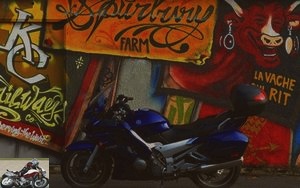
Conclusion
Easy to handle despite its size, the FJR is an excellent GT, comfortable and suitable for long trips. Its flexible engine offers a certain pleasure on long journeys with a torque available low enough not to have to play with the gearbox, except in the event of rapid overtaking on the motorway. Its only big flaw lies in the heat generated in the thighs, almost unbearable in town and in summer, but mitigated by a tank protector. It clearly benefits from being tested abroad, when its engine has not lost 44 bridle horsepower. But even in 100 horses, and nearly 1,500 euros less than the first competitor, it is the best quality / price ratio in the category..
Strong points
- Comfort
- The sobriety
- The price
Weak points
- Engine heat
Competitors: BMW R 1150 RT, Honda Pan European, Kawasaki ZZR 1200
Datasheet
The owners’ opinions on the test forum
Related articles
-
New re-evolution High-end road symbol of the manufacturer with tuning forks, the FJR 1300 descends from a long line of dynamic travelers. The first of…
-
Yamaha Fazer FZ6 S2 motorcycle test
The ultimate evolution of success The Fazer, now called FZ6 S2, celebrates its tenth anniversary. The engine originally from the Thundercat has been…
-
Alone in the world Single cylinder VVA of 124 cm3, 15 hp and 11.5 Nm, 140 kg full made, 4,599 euros Today, when you want to ride a vintage / retro /…
-
Appeared in 2006 and revamped in 2010, the XMAX 125 has remained at the top of sales since then with more than 8,000 sales in 2011. Yamaha thus seems to…
-
Yamaha Tracer 700 GT motorcycle test
Joys of possibilities Twin-cylinder in-line, 689 cm3, 74.8 hp, 68 Nm, 200 kg all full, available in A2, 8,999 euros. The Yamaha Tracer 700 Gt! Here is a…
-
Yamaha FZ1 Fazer S 1000 motorcycle test
The Swiss Army Knife sharpened – test in five 2007 vintage days Initially launched in 2000, the FZ1 has massively evolved in its new vintage. Still from…
-
Yamaha Fazer 1000 motorcycle test
Arrival in France at the beginning of the year 2001, the big sister of the FZS 600 Fazer is available at dealers since March. Three months later, she…
-
Mini-size, maxi-pleasure Who would have said that a 125 cm3 mini scooter had its place in France? We were used to aggressive scooters with small wheels….
-
Suzuki Hayabusa GSX-R 1300 test
First motorcycle to overtake the legendary 300 km / h bar, kilometer standing start in less than 18 seconds, the Hayabusa was talked about from its…
-
Yamaha TMax 530 ABS scooter test
The Thug Star The TMax is the big Yamaha scoot, even THE big benchmark maxi-scooter, to such an extent that it is the main target of copies of the…